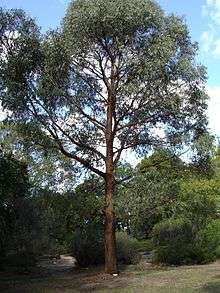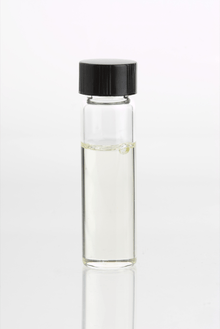Eucalyptus radiata
| Narrow-leafed peppermint | |
|---|---|
 | |
| Eucalyptus radiata, Melbourne | |
| Scientific classification | |
| Kingdom: | Plantae |
| (unranked): | Angiosperms |
| (unranked): | Eudicots |
| (unranked): | Rosids |
| Order: | Myrtales |
| Family: | Myrtaceae |
| Genus: | Eucalyptus |
| Species: | E. radiata |
| Binomial name | |
| Eucalyptus radiata | |
Eucalyptus radiata, commonly known as the Narrow-leaved peppermint or Forth River Peppermint, is a medium to tall tree to 30 m high (rarely 50 m) with persistent bark on the trunk and larger branches or persistent to smaller branches. The bark shortly fibrous ("peppermint"), grey to grey-brown, shedding in long ribbons. The branchlets are green. Adult leaves are narrow lanceolate or lanceolate, falcate, acute, basally tapered, glossy or semi-glossy, green, thin, concolorous, 7–15 cm long, 0.7–1.5 cm wide.
Summer flowers are cream yellow.[1]
The species occurs in Queensland, New South Wales, Victoria, the Australian Capital Territory and Tasmania.[2]
Uses

E.radiata has six known chemotypes of essential oil. The leaves are distilled for cineole and phellandrene based eucalyptus oils. E.radiata was the first eucalyptus species to be commercially utilized for oil by Melbourne pharmacist, Joseph Bosisto, in 1854 as "Eucalyptus amygdalina".[3]
References
- ↑ CSIRO: Eucalyptus radiata
- ↑ "Eucalyptus radiata Sieber ex DC.". Australian Plant Name Index (APNI), IBIS database. Centre for Plant Biodiversity Research, Australian Government.
- ↑ Boland, D.J., Brophy, J.J., and A.P.N. House, Eucalyptus Leaf Oils, 1991, ISBN 0-909605-69-6
-
.jpg)
Adult leaves
-

Bark and trunk detail